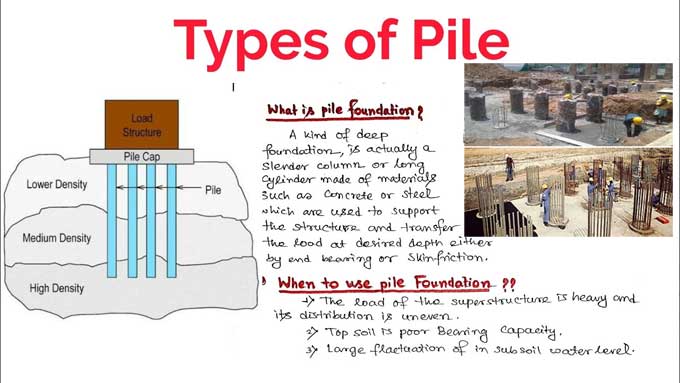
Different types of Pile Foundation and their use in Construction
Deep foundations and shallow foundations can both be classified. The shallow foundation is typically used when a structure has small loads relative to the soil-bearing capacity. A deep foundation is required when soils at the surface are incapable of bearing loads and they have to be transferred to deeper layers.
Uses of Pile Foundation
As a foundation, piles transfer the loads from superstructures to stronger, less compressible, stiffer soil or rock at depth, which increases the effective dimension of a foundation while resisting horizontal loads. Typically, they are used when soil conditions do not allow excessive settlement of structures.
Pile foundations must be carefully designed since they carry a great deal of weight. It is essential that a good engineer studies the soil before placing piles in it to ensure that the soil can support the loads.
There is a zone of influence around every pile on the soil. In order to ensure that loads are evenly distributed over the bulb of soil, piles should be spread far enough apart. Do not concentrate loads in a few areas.
Below is a list of situations where pile foundations are useful:
- There is a high groundwater table.
- Several heavy and non-uniform loads are imposed on the superstructure.
- In some cases, it is costlier or not feasible to use another type of foundation.
- Compressible soil occurs at shallow depths.
- If the river bed or seashore is close to its location, there is a possibility of scouring.
- If there is deep drainage system or canals close to the structure.
- Poor soil conditions make it impossible to excavate the soil to the desired depth.
- Due to heavy seepage into the foundation trenches, pumps or any other method cannot keep them dry.
Classifications of Pile Foundation
A pile foundation is used to distribute and transfer load through a layer of material with inadequate bearing, slipping of uplift capacity to a layer of material able to support the load without detrimental displacement.
Piles are available in various types for the support of soils with varying types of properties and structural requirements. Pile types may be classified by the design function such as end bearing, friction, or a combination or by how they are constructed, such as displacement or replacement.
Pile Installation Method
Various methods are used to install piles, each of which is chosen according to its needs. You may want to consider the following factors when choosing what kind of pile to use and the way to install it:
- Excavation depth.
- Materials used to make your piles.
- Pile driving angle.
- Environment issues that might affect residents, wildlife, or flora.
You will better understand how to decide between displacement and replacement, once you have assessed your needs. In displacement pilings, piles are driven into the ground without removing any material from the ground beforehand. Installation of replacement pilings involves excavating a hole into which the pile is then maneuvered.
A variety of instrumentation types should be considered during the design of pile load tests. Instruments should have enough precision to measure the needed data so that the designer can select the correct instrument. The constant monitoring of the condition of the pile under load is accomplished using permanent instrumentation. In addition to providing useful information about foundation behavior, permanent instrumentation can provide insight into the analysis and design assumptions in general.
How to choose the right pile foundation type based on criteria and methods.
Structural and Geotechnical Coordination
Engineers, geologists, and geotechnical engineers should work together in a coordinated effort to ensure that the results of the pile foundation analysis are properly integrated into the overall foundation design. Plans, specifications, pre-construction meetings, and the construction process are all coordinated.
Failure
Failures of structures and foundations can be classified as collapses or functional failures. Failure is caused by excessive deflections, differential movements that are not acceptable, vibrations that are excessive and premature deterioration that occurs as a result of environmental factors.
If critical structures do not meet functional requirements, the risk of collapse may be as great as that a lesser structure collapses. Designers should be aware not only of the risk of collapse, but also of the impact of settlement and vibrations on functional performance.
Safety
The factors of safety describe the reserve capacity that a foundation or structure has against collapse under given conditions and loads. When the design parameters and loads are unknown, they require a higher factor of safety than when they are well understood. Designers must be confident about the soil and pile parameters and the analysis for most hydraulic structures.
Instead of demanding a high factor of safety, it is better to minimize the uncertainty in the selection and analysis of design parameters. There is no cost-benefit in reducing the uncertainty in the analysis and design by conducting additional studies, testing, etc, when the structure is of less consequence.
Soil ?Structure
A foundation exploration and testing program will be designed according to the economic impact and functional significance of the structure. It should describe the pile test program, settlement and seepage analyses, and the analytical models for the pile and structure. To design a pile foundation for a critical structure, certain parameters must be specified, such as soil types and profiles, soil strengths, etc.


